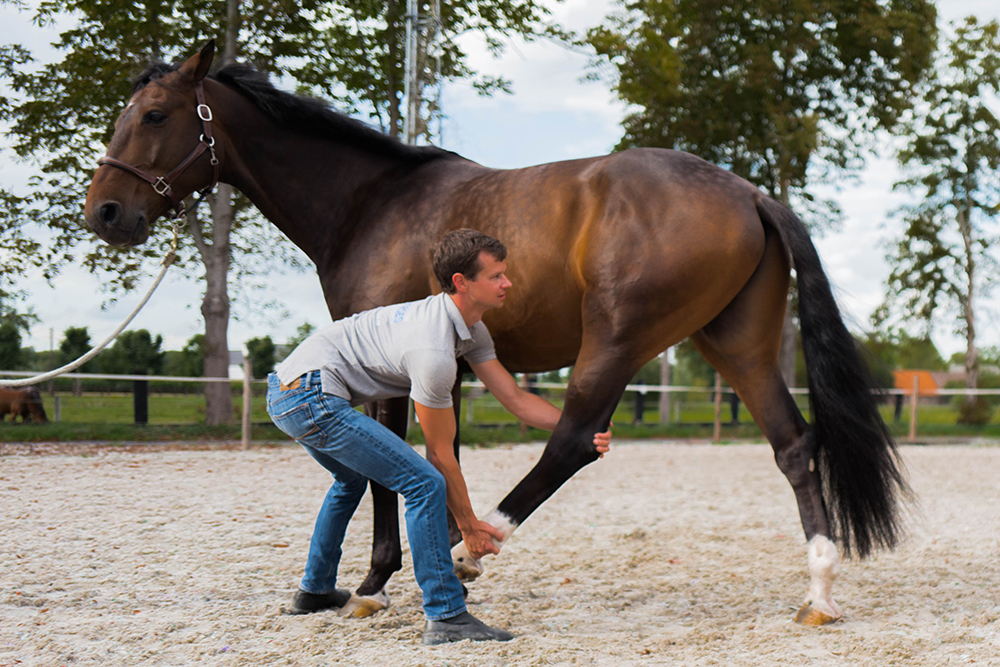Besides the daily training that may consist out of riding, lunging or an outdoor ride, stretching exercises can also be used to keep your horse fit. Important with the following exercises is that you only do them with a healthy and injury-free horse. Do not force any movement but invite your horse into it with something tasty and build up the suppleness together.
1. Chin to Chest: This exercise stimulates the flexibility of both the front and middle parts of the neck muscles.
- Stand next to your horse's shoulder, facing the horse's head. Hold the treat in your hand closest to the horse.
- Hold the hand with the reward in front of your horse's chest, asking him to bring the chin to the chest. Let him hold the position for a few seconds and then relax again.
As your horse masters these exercises, you can bring him closer to the chest each time. A variation on this is to bring the head more toward the bottom of the chest to engage the upper and middle part of the neck.
2. Chin to ball: With this exercise you focus on the withers. It is important here that the front legs are not too close together, as your horse needs to be able to put his nose between them.
- Stand next to your horse, at the height of where your girth normally lies, facing your horse's head. Hold the treat in your closest hand to the horse.
- Put the reward between the front legs and ask him to lower the head to the bullets. Hold this for a while but do not tilt the head.
As your horse gets better at these exercises, you can guide him further between the forelegs by asking more toward the belly with your hand.
3. Chin to hind leg (ball): This exercise stimulates longitudinal flexion of the neck and back as well as the muscles that provide stability in the abdomen and pelvis.
- Stand at the level of your horse's loins, facing back toward your horse's head. The reward should now be in the hand away from the horse.
- Hold the reward at about 50cm from your horse, inviting him to stick out the chin by reaching as far back and down as possible.
The more your horse gets the hang of this, the further you can go to the hind leg. Attention: your horse should not take a step to take the reward.
4. Bulging the withers, back and raising the sternum: This exercise provides more balance.
- Stand next to your horse, behind the elbow, facing your horse.
- Press lightly on your horse's sternum. Slowly move the pressure to just behind the girth location. You will notice that you are doing the right thing when your horse's back bulges and the withers, sternum and his back move upward.
Each horse will respond differently to this. Some will already need a little more pressure than others. Gradually increase the pressure until you notice your horse responding.
5. Tilting the pelvis and bulging the lumbar vertebrae: This stimulates the tilting of the pelvis and the bulging of the lumbar vertebrae, which has an effect on the carrying capacity of the hind leg.
- Stand next to your horse, facing the flank.
- Start at the base of the tail and move up along the spine. Next to each vertebra put pressure until your horse tilts the pelvis and bulges the lumbar vertebrae
- Another way is to stand behind your horse (if you are sure it is not striking). Then you put your nail (possibly of the thumb) on the top of the pooch and go in a perpendicular line down to the buttocks in the groove between the muscles of the hindquarters
Not all horses will respond to this or want to give in to the pressure quickly. Try and find out what your horse likes and where the right point for reaction is.
These exercises are for a change to make your horse more supple and loose in his body. Be careful not to repeat this exercise too long and not too often to not force anything. Build up carefully and see how your horse responds.
Source: Dochorse / Thehorse.com





